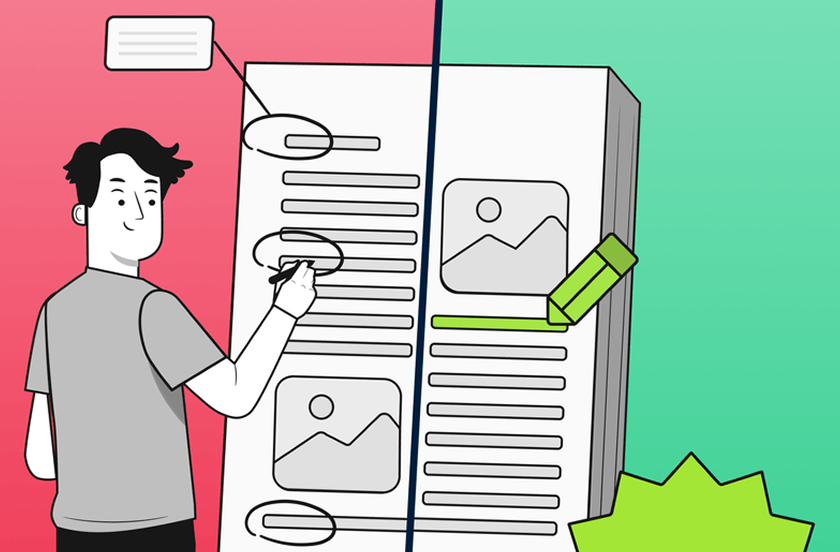They Had 3,000 Help Articles Nobody Read. Here's What They Did.
Published on
September 30, 2025






















.png)
Documentation debt is silent but expensive. Most companies either throw more people at it or add another tool. This team found a third way: turn the content you're already creating (videos, demos, customer calls) into documentation automatically.
Note: Names and specific company details have been anonymized to protect confidentiality while preserving the valuable insights from this conversation.
A customer experience leader at a global mapping technology company had a problem that would sound familiar to any B2B SaaS leader. Her team was sitting on 3,000 knowledge base articles that hadn't been reviewed in years. Most had single-digit view counts. The documentation was so outdated that customers regularly complained about instructions that didn't match the current product interface.
"We have 13,000 customers globally, but our documentation only served about 1,500 of them effectively," the CX leader explained during a recent conversation. "We were so myopic in what we were trying to solve for. We built for what we thought customers should be using, not what they were actually using."
The breaking point came when she discovered her company was auto-renewing a $67,000 community platform that had "slim to none" usage. Meanwhile, her customer success managers were flooding product managers with basic questions on Slack because they couldn't find internal documentation. Enterprise customers paying $6 million annually had no clear implementation documentation.
The Hidden Cost of Documentation Debt
Documentation debt compounds silently. While engineering teams recognize technical debt as a serious threat to velocity, documentation debt often gets ignored until it reaches crisis levels. For this team, that crisis looked like:
- 500+ hours annually spent creating and updating training materials
- 75% of documentation with near-zero views
- CSMs asking product managers basic questions via Slack instead of finding answers
- Enterprise customers with no implementation documentation despite million-dollar contracts
- Multiple disconnected systems including vanilla docs, community platforms, and various knowledge bases from acquisitions
"We had all these different systems - Pendo, vanilla community, vanilla docs - and we were just auto-renewing without asking why," she noted. "Each system only solved for small aspects of the customer journey. We were never going to be able to scale."
Why Traditional Approaches Fail
Many companies try to solve documentation problems by throwing more people at it. This leader knew better. With just two people dedicated to documentation, she calculated it would take months to review and update everything - and by then, the product would have changed again.
The other common approach - implementing an AI chatbot - had its own problems. "Are we even ready yet to have an AI chatbot for real support? No," she admitted. "We needed to figure out what systems we were using first."
Her engineering team wanted to build their own solution with Claude, but that created another challenge: where would the content come from? As she put it bluntly: "Garbage in, garbage out. What are we going to talk to people about? How are we going to talk to people?"
The Video Revolution Nobody Saw Coming
The breakthrough came from an unexpected source. The team had hundreds of hours of recorded content - sales engineer demos, product walkthroughs, customer training sessions, even Gong recordings of customer calls. This video content represented the actual knowledge her team needed, but it was trapped in an unusable format.
"We have 30-40 minute videos, and no one wants to watch them to find a 15-minute answer," she explained. The videos were expensive to create and impossible to keep updated. Every product change meant either leaving outdated videos live or spending thousands on re-recording.
When presented with the ability to automatically transform these videos into searchable, structured documentation, she immediately saw the potential. A single product walkthrough video could generate 20-30 articles, each with embedded video snippets showing exactly the relevant portion.
"If we're just taking internal videos and scraping them to create customer-facing stuff, that actually makes us a lot easier," she realized. "Someone from the product team could do a training video, upload it, and that's our knowledge base ready to go."
Four Problems, One Solution
The CX leader quickly identified four critical use cases that could transform her company's customer experience:
- SDR/BDR enablement: Creating a knowledge base for sales teams to answer customer questions without constantly pinging product managers
- Pricing and packaging changes: Building comprehensive documentation for a major pricing restructure without manual documentation efforts
- Internal CSM documentation: Giving customer success managers instant answers about products instead of flooding Slack channels with questions
- Customer-specific implementation guides: Taking sales engineer scoping calls and automatically creating personalized documentation for each enterprise customer
That last point particularly excited her. "When a sales engineer is doing a call with a customer and scoping something, I can take that out and create internal documentation for that customer so I completely understand their implementation."
The Multiplier Effect
What started as a documentation problem revealed itself as an opportunity for transformation. By connecting video generation capabilities with a Slack integration, the team could create what she called an "ask me anything environment" where teams could get instant, accurate answers pulled from all their content sources.
"These people pay us $6 million," she emphasized about their enterprise customers. "How do we not know their implementation details?"
The ability to maintain customer-specific knowledge bases suddenly made personalization at scale possible. Instead of generic documentation that served only 11% of their customer base effectively, they could create targeted content for different user segments, different use cases, and even individual enterprise accounts.
Moving From Reactive to Proactive
This story illustrates a critical shift happening in B2B SaaS documentation. Companies are moving from treating documentation as a necessary evil to recognizing it as a strategic asset. When documentation can be generated from the work teams are already doing - recording demos, conducting training sessions, having customer calls - it stops being a burden and becomes a natural output of daily operations.
"This removes the human in the loop for keeping stuff updated," the leader noted. "I'm not trying to replace humans everywhere, but that manual task of documentation maintenance is a problem."
For companies drowning in documentation debt, this approach offers a practical path forward. Instead of trying to fix thousands of outdated articles, start fresh with the content you're already creating. Transform those sales demos, training sessions, and product walkthroughs into searchable, maintainable documentation that actually serves your customers.
The technology exists today to make this transformation. The question is whether companies will continue treating documentation as an afterthought or recognize it as the strategic differentiator it can be. For this team, with their upcoming budget cycle and a clear vision for transformation, the answer was obvious.
As she prepared to present this approach to her CTO and CRO, the CX leader was confident: "I know this is a pain point for both of us. And now we have a way to solve it that actually makes sense for our scale."
import time
import requests
from opentelemetry import trace, metrics
from opentelemetry.sdk.trace import TracerProvider
from opentelemetry.sdk.metrics import MeterProvider
from opentelemetry.sdk.trace.export import ConsoleSpanExporter, SimpleSpanProcessor
from opentelemetry.sdk.metrics.export import ConsoleMetricExporter, PeriodicExportingMetricReader
# --- 1. OpenTelemetry Setup for Observability ---
# Configure exporters to print telemetry data to the console.
# In a production system, these would export to a backend like Prometheus or Jaeger.
trace.set_tracer_provider(TracerProvider())
tracer = trace.get_tracer(__name__)
span_processor = SimpleSpanProcessor(ConsoleSpanExporter())
trace.get_tracer_provider().add_span_processor(span_processor)
metric_reader = PeriodicExportingMetricReader(ConsoleMetricExporter())
metrics.set_meter_provider(MeterProvider(metric_readers=[metric_reader]))
meter = metrics.get_meter(__name__)
# Create custom OpenTelemetry metrics
agent_latency_histogram = meter.create_histogram("agent.latency", unit="ms", description="Agent response time")
agent_invocations_counter = meter.create_counter("agent.invocations", description="Number of times the agent is invoked")
hallucination_rate_gauge = meter.create_gauge("agent.hallucination_rate", unit="percentage", description="Rate of hallucinated responses")
pii_exposure_counter = meter.create_counter("agent.pii_exposure.count", description="Count of responses with PII exposure")
# --- 2. Define the Agent using NeMo Agent Toolkit concepts ---
# The NeMo Agent Toolkit orchestrates agents, tools, and workflows, often via configuration.
# This class simulates an agent that would be managed by the toolkit.
class MultimodalSupportAgent:
def __init__(self, model_endpoint):
self.model_endpoint = model_endpoint
# The toolkit would route incoming requests to this method.
def process_query(self, query, context_data):
# Start an OpenTelemetry span to trace this specific execution.
with tracer.start_as_current_span("agent.process_query") as span:
start_time = time.time()
span.set_attribute("query.text", query)
span.set_attribute("context.data_types", [type(d).__name__ for d in context_data])
# In a real scenario, this would involve complex logic and tool calls.
print(f"\nAgent processing query: '{query}'...")
time.sleep(0.5) # Simulate work (e.g., tool calls, model inference)
agent_response = f"Generated answer for '{query}' based on provided context."
latency = (time.time() - start_time) * 1000
# Record metrics
agent_latency_histogram.record(latency)
agent_invocations_counter.add(1)
span.set_attribute("agent.response", agent_response)
span.set_attribute("agent.latency_ms", latency)
return {"response": agent_response, "latency_ms": latency}
# --- 3. Define the Evaluation Logic using NeMo Evaluator ---
# This function simulates calling the NeMo Evaluator microservice API.
def run_nemo_evaluation(agent_response, ground_truth_data):
with tracer.start_as_current_span("evaluator.run") as span:
print("Submitting response to NeMo Evaluator...")
# In a real system, you would make an HTTP request to the NeMo Evaluator service.
# eval_endpoint = "http://nemo-evaluator-service/v1/evaluate"
# payload = {"response": agent_response, "ground_truth": ground_truth_data}
# response = requests.post(eval_endpoint, json=payload)
# evaluation_results = response.json()
# Mocking the evaluator's response for this example.
time.sleep(0.2) # Simulate network and evaluation latency
mock_results = {
"answer_accuracy": 0.95,
"hallucination_rate": 0.05,
"pii_exposure": False,
"toxicity_score": 0.01,
"latency": 25.5
}
span.set_attribute("eval.results", str(mock_results))
print(f"Evaluation complete: {mock_results}")
return mock_results
# --- 4. The Main Agent Evaluation Loop ---
def agent_evaluation_loop(agent, query, context, ground_truth):
with tracer.start_as_current_span("agent_evaluation_loop") as parent_span:
# Step 1: Agent processes the query
output = agent.process_query(query, context)
# Step 2: Response is evaluated by NeMo Evaluator
eval_metrics = run_nemo_evaluation(output["response"], ground_truth)
# Step 3: Log evaluation results using OpenTelemetry metrics
hallucination_rate_gauge.set(eval_metrics.get("hallucination_rate", 0.0))
if eval_metrics.get("pii_exposure", False):
pii_exposure_counter.add(1)
# Add evaluation metrics as events to the parent span for rich, contextual traces.
parent_span.add_event("EvaluationComplete", attributes=eval_metrics)
# Step 4: (Optional) Trigger retraining or alerts based on metrics
if eval_metrics["answer_accuracy"] < 0.8:
print("[ALERT] Accuracy has dropped below threshold! Triggering retraining workflow.")
parent_span.set_status(trace.Status(trace.StatusCode.ERROR, "Low Accuracy Detected"))
# --- Run the Example ---
if __name__ == "__main__":
support_agent = MultimodalSupportAgent(model_endpoint="http://model-server/invoke")
# Simulate an incoming user request with multimodal context
user_query = "What is the status of my recent order?"
context_documents = ["order_invoice.pdf", "customer_history.csv"]
ground_truth = {"expected_answer": "Your order #1234 has shipped."}
# Execute the loop
agent_evaluation_loop(support_agent, user_query, context_documents, ground_truth)
# In a real application, the metric reader would run in the background.
# We call it explicitly here to see the output.
metric_reader.collect()Recent Posts...
You'll receive the latest insights from the Brainfish blog every other week if you join the Brainfish blog.









.png)

